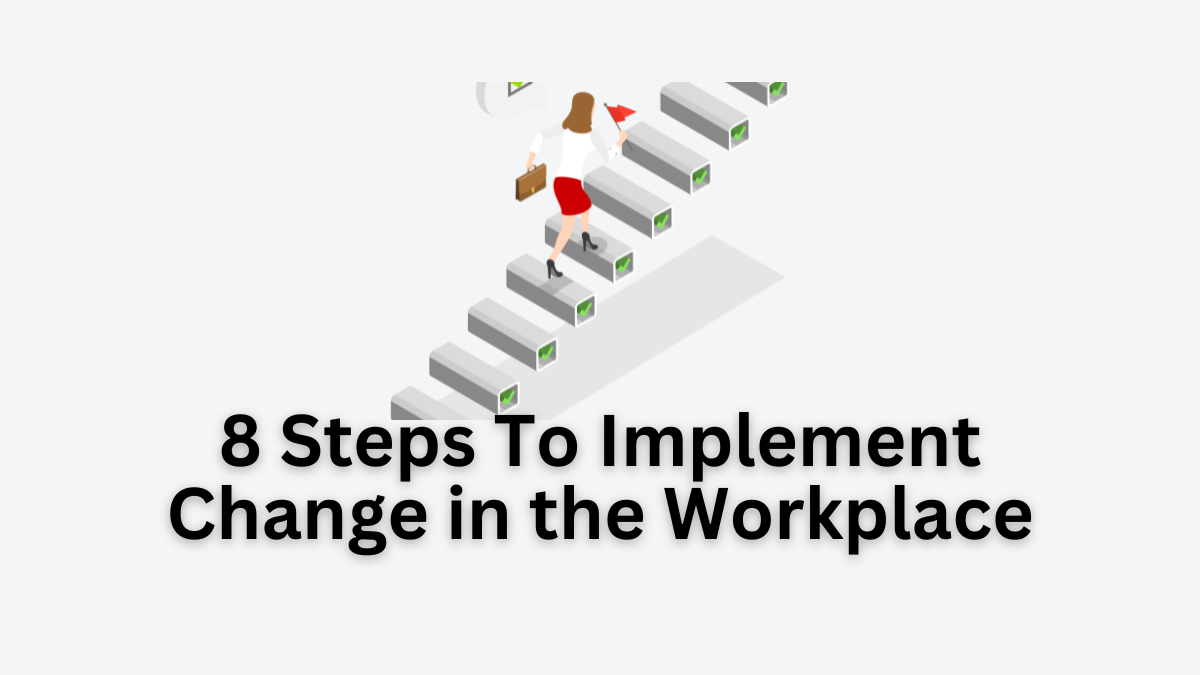Steps To Implement Change in the Workplace
Successful change management in the organization requires careful implementation of some phases. Here, we will explore the eight major steps to successfully implement change in the workplace:
Identify Necessary Changes
Successful change begins with a thorough assessment of the organization’s goals, values, and mission. Any proposed changes should align seamlessly with these foundational elements.
Engage decision-making teams and employees in discussions to validate the necessity of the changes, ensuring that all stakeholders have a voice in the process. This collaborative approach not only garners support but also promotes a sense of ownership among employees.
Establish Clear Change Leaders
Assigning capable leaders and coordinators is pivotal for the success of change initiatives. These individuals should not only possess a deep understanding of the proposed changes but also be skilled communicators and influencers.
Align responsibilities based on departmental relevance, allowing leaders to emerge organically from areas directly impacted by the change. This tailored approach ensures that change leaders have a fine understanding of the challenges and opportunities within their purview.
Develop a Comprehensive Change Plan
Crafting a robust change plan is akin to creating a roadmap for the organization’s transformation. This plan should encompass every aspect of the implementation process, including key milestones, deadlines, and communication strategies.
Importantly, integrate measurable metrics into the plan, providing a tangible means to assess the success of the changes. These metrics could range from employee satisfaction levels to improvements in operational efficiency.
Prepare Teams and Individuals
Change is often met with resistance, and preparing teams and individuals for the impending transformation is crucial. Allocate sufficient time for preparation before the changes take effect.
Clearly articulate the reasons behind the changes, fostering a sense of urgency and necessity among employees. Providing context and outlining the positive impact of the changes on both individual roles and the organization as a whole helps build understanding and reduces apprehension.
Read More: What is Resistance To Change?
Communicate Changes and Timelines
Communication is the linchpin of successful change management. Ensure that communication about the change process is clear, consistent, and reaches all levels of the organization.
Host interactive sessions, and town hall meetings, and utilize various communication channels to disseminate information effectively. Discuss the steps involved, the timelines for each phase, and the final deadline for the change implementation. Transparency and openness in communication build trust and mitigate uncertainties.
Share Documentation
Clear and accessible documentation is essential for navigating the complexities of change. Provide detailed information about the changes, offering a reference point for employees.
Additionally, offers training programs to assist employees in adapting to the new processes. Training fosters a culture of continuous learning, empowering individuals to acquire the skills needed for success in the transformed landscape.
Read More: 15 Causes of Resistance To Change
Institute the Change
Executing the change according to the established plan is a critical phase. Adherence to the schedule is paramount, ensuring a smooth transition.
Be prepared to address questions, concerns, and potential challenges that may arise before and after the implementation deadline. Proactive management during this phase contributes to a positive employee experience and minimizes disruptions.
Sustain Momentum
Change is an ongoing process that requires continuous monitoring and adjustment. Conduct regular follow-ups with teams to assess their experiences and gather feedback.
Identify and address any issues in the change management strategy promptly. This commitment to ongoing improvement fosters a culture of adaptability and innovation, ensuring that the organization remains resilient in the face of future changes.
Hence, these are the eight steps to effectively implement change in the workplace.
Read Next: Organizational Barrier in Communication

Sujan Chaudhary holds a Bachelor in Business Administration (BBA) degree and is currently pursuing an MBA degree. He loves to share his business knowledge with the rest of the world.
